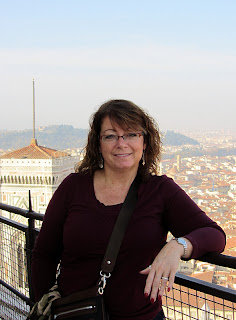On Wednesday's I my first class wasn't until 3pm, so I usually spent my Wednesday's exploring Florence, sleeping in, going to the gym. The Wednesday my parents were here we decided to visit the city of Pisa before my Italian class. We hopped on a morning train from Santa Maria Novella train station, Florence and arrived at Pisa Centrale an hour later.
Pisa peaked in power in AD1200 it used to rival Venice and Genoa as a sea-trading power. As a port near the mouth of the Arno River (the same river that flows through Florence) the city enjoyed easy access to the Mediterranean. Pisa's three important sights - the Duomo, Baptistery and the Tower - can all be found on the Field of Miracles. The buildings are constructed from similar materials bright white marble and have comparable decoration. The style is dubbed as Pisan Romanesque. We walked from the train station to the Field of Miracles to see these beautiful sights.
The Leaning Tower: a 15ft lean from the vertical makes the Tower one of Europe's most recognizable images. You cannot imagine how much this gigantic tower is actually leaning until you see if for yourself. The Tower is nearly 200ft tall and 55ft wide, weighing 14,000 tons and is currently leaning at a 5 degree angle. The tower started to lean almost immediately after construction began There are eight stories to the Tower and it was built over two centuries by least three different architects. Each successive architect tried to correct the leaning problem.. and after completion several attempts were made to stop its slow-motion fall...
Duomo (Cathedral)
Dad holding up the Tower
can't see it without doing the tourist pics
Baptistery
Field of Miracles
Bordering the Field of Miracles is the Camposanto Cemetery, which has been there since ancient times and is said to have "Holy Land" dirt, which is said to reduce a body into a skeleton within a day - crazy. The building is also home to the 1,000 square foot 14th century fresco, The Triumph of David which captured Pisa's mood in the wake of the bubonic plague.
sarcophagus
After we visited the important sites at the field of Miracles, it was time to head back to Florence so I could get to class. While I attended Italian and my literature class, my parents explored Florence on their own, got some afternoon cappuccinos and visited Santa Croce. Santa Croce Church is a 14th century Franciscan church decorated with centuries of art, and holds the tombs of great Florentines. Although built in the 14th century, Santa Croce has a 19th century Victorian Gothic facade facing a huge square ringed with shops and littered with tourists. Inside the church there is the tomb of Galileo Galilei, and Michelangelo Buonarroti.
Santa Croce
restoration in process
Galileo's Tomb
Michelangelo's Tomb
Thursday I had class from 9am to 11:30 then again at 3pm. Mom and Dad took advantage of the time to climb the Duomo and visit the Academia to see the statue of David. Climbing the Duomo gives a grand view into the cathedral from the base of the dome, a chance to see Brunelleschi's "dome-within-a-dome" (style in which Michelangelo used to construct the dome of St. Peter's) construction, glorious views of Florence from the top and the opportunity to use a Renaissance StairMaster, 463 step climb to the top!
small windows on the way up
narrow stairs and hallways
made it to the top!
check out the view
didn't even break a sweat
463 up, another 463 down
looking up at the front of the Duomo
The Duomo – formally known as Cathedrale di Santa Maria del Fiore – is Florence’s Goethic Cathedral that has the third largest naïve in Christendom. The façade from the 1870s is covered with pink, green and white Tuscan marble. The claim to fame is Brunelleschi’s magnificent dome – the first Renaissance dome and the model for all domes to follow. The cathedral was actually built with a giant hole, awaiting a roof – without any technology or plan on how to build one. The original architect, Arnolfo left a problem that was insolvable for more than 100 years. Fortunately Filippo Brunelleschi constructed an idea to build a dome-within-a-dome structure that could encompass the area and support itself.
The Accademia ( Galleria dell’Accedemia) is home to Michelangelo’s magnificent sculpture of David. If you’ve looked through my pictures, you can see that there is a David statue in Piazza Signora, where the original used to stand. They have since moved it in to the museum for protection. Michelangelo was commissioned in 1501 at the age of 26 to carve a large scale work from a Bible story. To quickly explain the significance, according to the story - the Israelites were surrounded by barbarian warriors led by a giant named Goliath. The Giant challenged the Israelites to send someone to fight him, a young shepherd boy named David defeats the giant. The statue that Michelangelo commissioned stands 17ft tall and is a symbol of divine victory over evil. It was originally supposed to stand on the roofline of the Duomo, then was placed more prominently at the entrance to Palazzo Vecchio - where the copy stands today.




















No comments:
Post a Comment